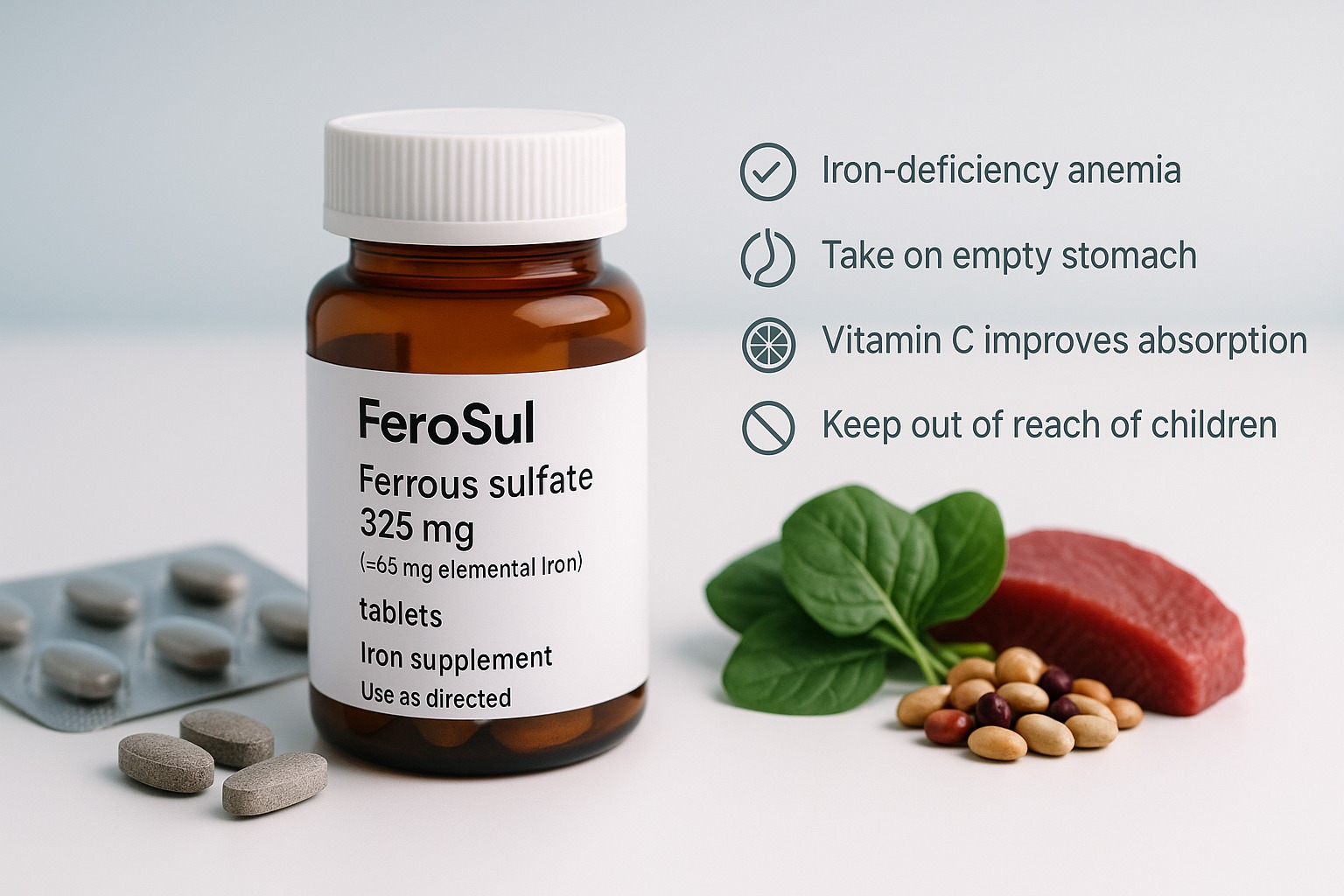FeroSul is a brand of ferrous sulfate, an iron supplement commonly used to treat or prevent iron-deficiency anaemia. It is available in several strengths and formats (tablets/liquid) depending on your country.
Quick disclaimer: This guide is for education only and not a substitute for medical advice. Dosing, labels, and OTC/prescription status vary across the US, UK, Canada, Australia, and Europe. Always follow your clinician and the Patient Information Leaflet for the exact product you have.
What FeroSul Is Used For
- Treating iron-deficiency anaemia confirmed by blood tests (low haemoglobin and ferritin)
- Preventing deficiency in higher-risk groups when advised by a clinician (e.g., during pregnancy, heavy periods, frequent blood donation, certain diets, or after blood loss)
Iron deficiency causes tiredness, weakness, shortness of breath, hair loss, and brittle nails. Correcting the deficiency restores iron stores and improves energy over weeks.
Strengths & What “Elemental Iron” Means
Many iron products list the salt (ferrous sulfate) and the amount of elemental iron your body can actually use.
- A common tablet is ferrous sulfate 325 mg which provides ≈65 mg elemental iron.
- Other strengths (e.g., ferrous sulfate 200 mg ≈ 65 mg in some regions, ferrous sulfate 300 mg ≈ 60 mg) exist—check your label.
- Liquids list elemental iron per mL (e.g., 6 mg/mL). Measure with the supplied syringe or spoon.
When comparing products, always compare elemental iron.
How to Take FeroSul (Step-by-Step)
Your exact plan depends on your blood tests and tolerance.
- Typical treatment dose: often 60–65 mg elemental iron once or twice daily; some people do well with every-other-day dosing to improve absorption and reduce side effects.
- When to take: best on an empty stomach (1 hour before or 2 hours after food). If it upsets your stomach, take with a small snack or at bedtime.
- Vitamin C helps: a glass of water is fine; orange juice or a vitamin C (ascorbic acid) tablet can boost absorption (if appropriate for you).
- Avoid these near your dose (2–4 hours apart): tea/coffee, milk or calcium, high-fibre bran, antacids, PPIs, H2 blockers, tetracyclines, quinolones, thyroxine, bisphosphonates.
- Swallow whole; do not crush extended-release tablets. For liquids, rinse your mouth or drink water afterwards to reduce tooth staining.
- Missed dose? Take it the same day when remembered; skip if it’s close to the next dose—don’t double.
Duration: Treatment usually continues 3 months after haemoglobin normalises to refill body stores (ferritin). Your clinician will recheck bloods and advise when to stop.
Side Effects & What to Do
Common (usually mild and improve with time):
- Nausea, upset stomach, metallic taste
- Constipation or diarrhoea
- Dark stools (harmless)
- Tooth staining with liquids (prevent with a straw and rinsing)
Helpful tips
- Try every-other-day dosing or switch timing (morning vs bedtime).
- Add fluids, fibre, and gentle activity for constipation; a stool softener may help if approved by your clinician.
- If symptoms persist or are severe, ask about a different iron salt or dose adjustment. Occasionally, IV iron is used when tablets aren’t suitable.
Serious—seek medical help urgently
- Signs of allergic reaction (rash, swelling, trouble breathing)
- Black, tarry stools with weakness or dizziness (could be bleeding—get urgent care)
Safety Warnings
- Keep out of reach of children. Accidental overdose of iron is a leading cause of fatal poisoning in children under 6. Store in child-resistant containers and seek emergency care if a child swallows iron tablets or liquid.
- Do not self-treat suspected anaemia without testing—too much iron can be harmful.
- Kidney disease, bowel disease, ulcers, transfusions, or disorders of iron overload (e.g., haemochromatosis) require specialist advice.
- Pregnancy & breastfeeding: Iron is often recommended during pregnancy, but dosing and target ferritin vary by country; follow your midwife/obstetrician.
- Vegetarian/vegan diets: Iron can be taken with vitamin C–rich foods to improve absorption from plant sources.
Interactions (Tell Your Clinician/Pharmacist)
- Levothyroxine: separate by 4 hours
- Tetracycline/quinolone antibiotics: separate by 2–6 hours
- Antacids/PPIs/H2 blockers, calcium, zinc, magnesium: reduce iron absorption—separate by 2–4 hours
- Bisphosphonates (alendronate etc.): separate by at least 2 hours
- Food & drink: tea/coffee, dairy, and high-bran foods reduce absorption; vitamin C improves it
Results: What to Expect
- Energy often improves within 1–2 weeks.
- Haemoglobin typically rises by ~1 g/dL (10 g/L) every 2–3 weeks once absorption is adequate.
- Ferritin (iron stores) may take 1–3 months longer to refill—keep taking iron as directed even after you feel better.
Frequently Asked Questions (FAQs)
1) Is FeroSul the same as ferrous sulfate?
Yes—FeroSul is a brand of ferrous sulfate. Compare elemental iron when switching brands or strengths.
2) Can I take it with food?
Empty stomach absorbs best, but light food is okay if you get nausea. Avoid tea/coffee/dairy around the dose.
3) My stools are black—is that normal?
Yes, iron darkens stools. Seek care if stools are tarry and you feel dizzy/weak.
4) What if tablets upset my stomach?
Try every-other-day dosing, a lower elemental iron dose, switching timing, or ask about a different iron salt or liquid.
5) Do I still need iron if I’m on a prenatal vitamin?
Possibly. Prenatals may not contain enough elemental iron to treat established deficiency—your clinician will check your ferritin and advise.
6) How long should I take it?
Usually until haemoglobin normalises plus 3 months to restore ferritin; confirm with a follow-up blood test.
7) Can iron cause constipation?
Yes. Increase fluids and fibre; a stool softener may help. If severe, speak with your clinician.
Bottom Line
FeroSul (ferrous sulfate) is an effective, widely available option for iron-deficiency anaemia when taken in the right dose, at the right time, and for long enough to rebuild iron stores. Use it exactly as directed, watch for side effects, keep it locked away from children, and follow up with blood tests to confirm recovery.


Leave a Comment